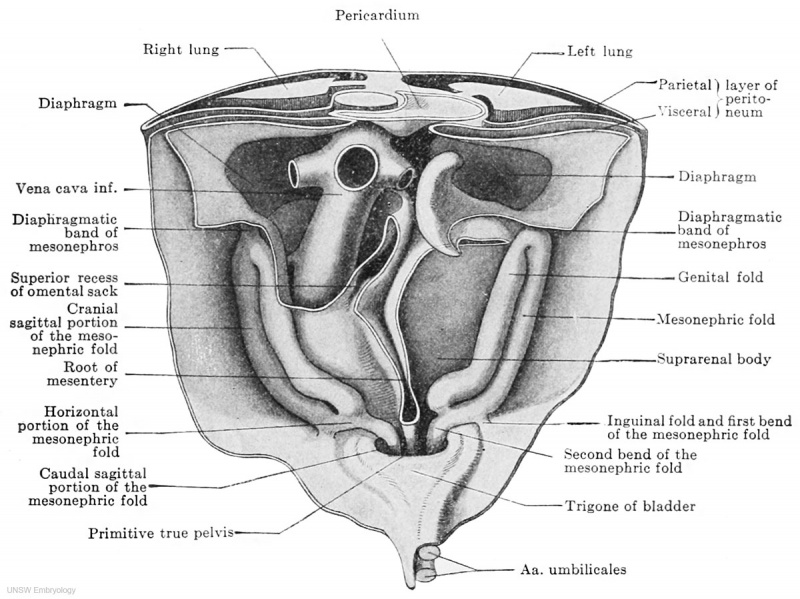File:Keibel Mall 2 631.jpg

Original file (1,200 × 898 pixels, file size: 192 KB, MIME type: image/jpeg)
Fig. 631. Model of the posterior abdominal wall of a human embryo of 19.4 mm greatest length
(Embryo Ma. 2, from the collection of Professor Hochstetter, Vienna.) Model prepared by my pupils Massard and Chome.
The urogenital fold is separated by a deep groove into the mesonephric and genital folds. The upper pole of both these folds is attached to the diaphragm by the diaphragmatic ligament of the mesonephros. The mesonephric fold is bent at two places, and we may recognize an upper sagittal, a horizontal, and a lower sagittal portion. At the first bend, between the upper sagittal and horizontal portions, the mesonephric fold is connected with the lateral wall of the abdomen by the inguinal fold.
| Embryology - 19 Apr 2024 |
|---|
| Google Translate - select your language from the list shown below (this will open a new external page) |
|
العربية | català | 中文 | 中國傳統的 | français | Deutsche | עִברִית | हिंदी | bahasa Indonesia | italiano | 日本語 | 한국어 | မြန်မာ | Pilipino | Polskie | português | ਪੰਜਾਬੀ ਦੇ | Română | русский | Español | Swahili | Svensk | ไทย | Türkçe | اردو | ייִדיש | Tiếng Việt These external translations are automated and may not be accurate. (More? About Translations) |
Felix W. The development of the urinogenital organs. In Keibel F. and Mall FP. Manual of Human Embryology II. (1912) J. B. Lippincott Company, Philadelphia. pp 752-979.
| Historic Disclaimer - information about historic embryology pages |
|---|
| Pages where the terms "Historic" (textbooks, papers, people, recommendations) appear on this site, and sections within pages where this disclaimer appears, indicate that the content and scientific understanding are specific to the time of publication. This means that while some scientific descriptions are still accurate, the terminology and interpretation of the developmental mechanisms reflect the understanding at the time of original publication and those of the preceding periods, these terms, interpretations and recommendations may not reflect our current scientific understanding. (More? Embryology History | Historic Embryology Papers) |
Cite this page: Hill, M.A. (2024, April 19) Embryology Keibel Mall 2 631.jpg. Retrieved from https://embryology.med.unsw.edu.au/embryology/index.php/File:Keibel_Mall_2_631.jpg
- © Dr Mark Hill 2024, UNSW Embryology ISBN: 978 0 7334 2609 4 - UNSW CRICOS Provider Code No. 00098G
File history
Click on a date/time to view the file as it appeared at that time.
| Date/Time | Thumbnail | Dimensions | User | Comment | |
|---|---|---|---|---|---|
| current | 08:41, 19 February 2014 |  | 1,200 × 898 (192 KB) | Z8600021 (talk | contribs) | ==Fig. 631. Model of the posterior abdominal wall of a human embryo of 19.4 mm greatest length== (Embryo Ma. 2, from the collection of Professor Hochstetter, Vienna.) Model prepared by my pupils Massard and Chome. The urogenital fold is separated by a... |
You cannot overwrite this file.
File usage
The following 2 pages use this file:
